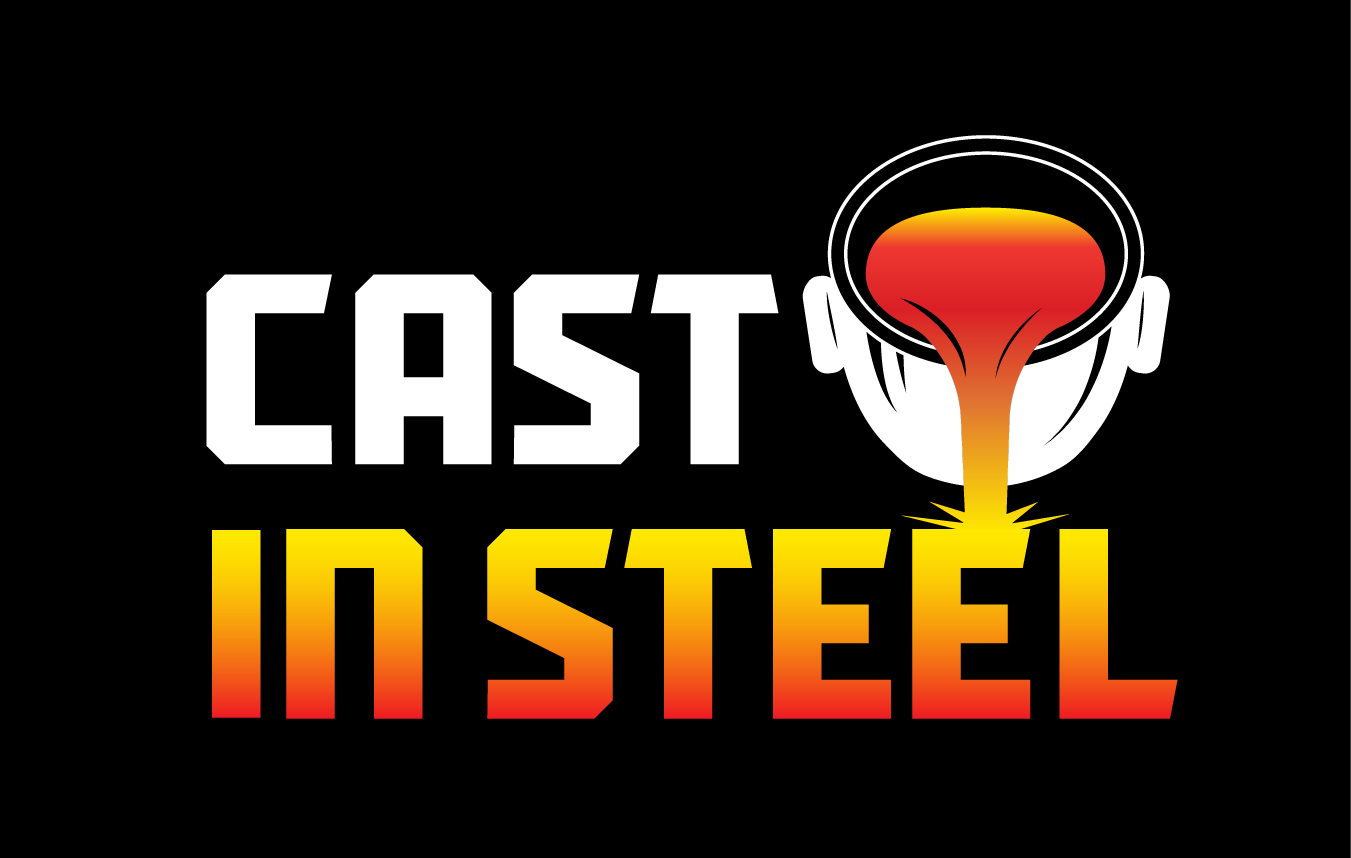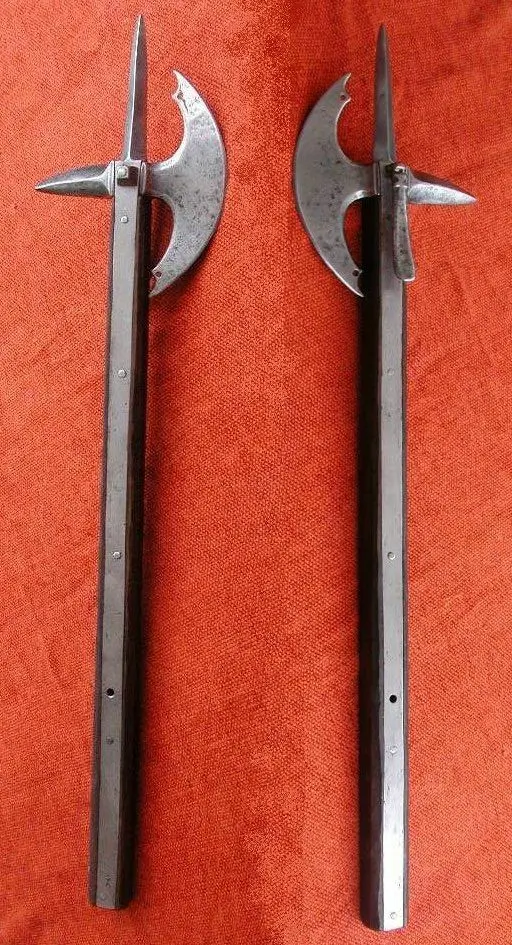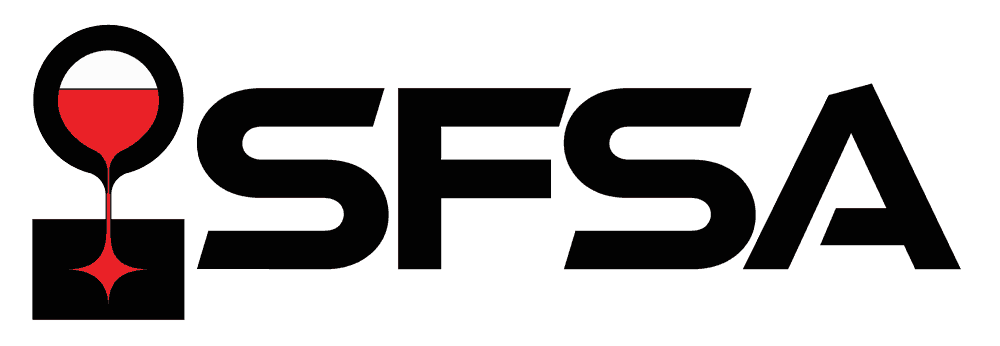Horseman’s Axe
Table of Contents


Cast in Steel 2026 will be a competition to produce a Horseman’s axe using casting.
Robert the Bruce, King of Scotland, used an axe to defeat Henry de Bohun in single combat at the start of the Battle of Bannockburn in 1314. Given that Bruce was wielding the axe on horseback, it is likely that it was a one handed horseman’s axe. They enjoyed a sustained revival among heavily armored equestrian combatants in the 15th century.
To the right is an example of a battle axe that was tailored for the use of a mounted knight. Note the hole on the haft for the accommodation of a leather strap to be passed over the wrist, the belt-hook for ease of carrying, and the langets. This example dates from the last quarter of the 15th century and is 69 cm (27 inches) long. The wooden haft is modern. The blade’s punched decoration suggests German make. Variations of this basic design include the fitting of a hammer face instead of a pointed pick behind the blade.
Competition information
Teams produce a Horseman’s Axe exploiting the casting process. Students may submit a preliminary plan to register, get advice, and make sure to get all updates. All teams must:
- Make their Horseman’s Axe
- Your axe should weigh no more than 1.5 kg (3.3 lbs.)
- Your axe should not be longer than 800mm (31.5 in.) in overall length.
- Submit a Technical Report for their project of less than 10 pages.
- Produce a Project Video, not to exceed 5 minutes.
All axes submitted for the competition become property of SFSA.
Teams must have:
- Students who will design, build, and test their Horseman’s axe. All team members must be students at a university, college, VOYECH or trade school. Teams are limited to 5 members.
- A faculty sponsor to help the team.
- An industrial partner familiar with steel castings.
Each axe entry will be evaluated in 5 categories in the competition:
- Design and Process from technical report
- Authenticity from the technical report
- Casting Creativity in their production
- Project Video documenting the team and their project
- Performance based on testing and expert evaluation
CIS 2026 Grand Prize will be $25,000 for the winning team
Friday, March 27, 2026 Project video, technical report, are due.
Friday, March 27, 2026 Horseman’s axe shipped by.
April 13-17, 2026 Cast in Steel performance testing
Your technical report must not exceed 10 pages. (This will include your cover page and resources pages so clear and concise writing is necessary) An appendix of figures and tables are allowed and do not count in the page total.
- Cover Page:
- Must use the outline of this cover page. An example cover page is included in the document.
- Address the following:
- State the reason for the competition: “SFSA has created this competition to encourage students to learn about making steel products using the casting process and applying the latest technology available”. This should be in the introduction of your Technical Report.
- The historical background and accuracy of your axe and explain why your axe is an authentic Horseman’s axe.
- Your use of casting technology to add value
- Your design process and the steps you took to get to your final product.
- Your use of NDT to ensure the integrity of your axe.
- Your final results should show that it meets contest requirements (state the final length, weight, and materials of your axe).
- Other suggested topics that can be addressed in your technical report:
- What metallurgical decisions were made with respect to your axe.
- What type of casting process was selected, what led you to that decision, and the casting process steps you used while creating your axe.
- What kind of inspection including NDT and testing your axe was subjected to before submission.
Event City: Grand Rapids, MI
Testing Venue: To Be Determined (TBD)
Metal Casting Congress
(Axes displayed before event at the FEF booth)
DeVos Place Convention Center
303 Monroe Avenue NW
Grand Rapids, MI
Ready to Compete?
CLICK HERE to register your team for the CIS 2026 competition.
CLICK HERE for the Cast In Steel Student Filming Guide. Teams are required to review and sign the release forms to participate in Cast In Steel.
Expert discussion
Experts and competition judges talk about the horseman’s axe
Discussion about what makes a “best casting”, and how to be a successful team in the competition
Discussion about what makes a good technical report for the competition
Frequently Asked Questions
- Will forging after the initial casting be allowed?
The casting requirement is open and evaluates the teams use of casting to add value and quality. All teams do finishing value added operations like grinding, heat treatment, polishing, etc. We consider forging a value added operation like machining or grinding. If you cast a block and machined out your axe, that would not be making use of the casting operation capability to create geometry and performance. In the same way if you cast a block and forge your axe from it, it is permitted but would not score well on the utilization of casting to produce the item. - Will we be allowed to make a handle out of wood for the axe or are we supposed to cast all/or most of it?
As above, there are no requirements or restrictions on the design of your Horseman’s axe beyond the weight and length cited on the announcement and on this page. You are able to be creative to maximize your competitiveness in your video, technical report and the axe itself. A critical component in scoring is the optimal use of casting to create value and performance. - In terms of handle, is a metallic handle required as in a fully cast metal handle, or can other materials be substituted as well?
The team is free to have any combination of materials for their item. The casting requirement is to use casting creatively to add value and improve performance. You are free to use any other materials you want to make the best axe. - What are the alloy restrictions for this competition?
No restrictions or requirements. It is a steel competition, so SFSA will support your team and find a foundry willing to pour it in steel. Teams often may make a pattern or a mold at another facility and we get them a steel foundry to pour the molds in a selected alloy. Send me a note if you need a steel source. - Is any additional information available regarding the testing procedures, expectations, or anything else you feel would be helpful for us to know as we prepare?
Look at the Expert discussion videos on this page. They provide a rich background in the competition. You should also look at videos from earlier competitions and the older reports and prior tests. - If we are running two teams from a single university, do we need two separate faculty to be our sponsor/advisor?
No. Multiple teams can use the same advisor, and can also use the same industry partner.
References
- View the 2025 competition – George Washington’s Sword
- View the 2024 competition – Halligan Bar
- View the 2023 competition – African Spear Point
- View the 2022 competition – Celtic Leaf Sword
- View the 2021 competition – Thor’s Hammer
- View the 2020 competition – Bowie Knife
- View the 2019 competition – Viking Axe

